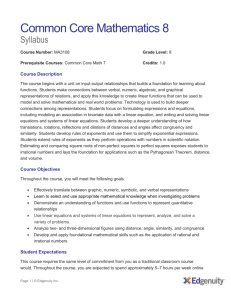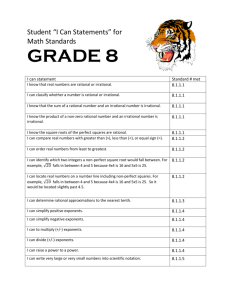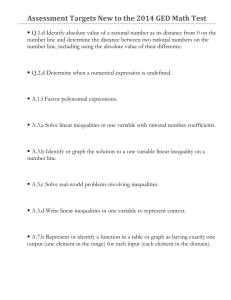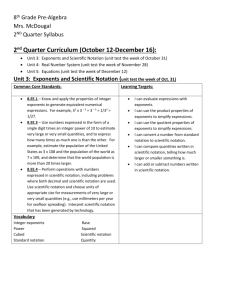Pepperell Middle School
advertisement
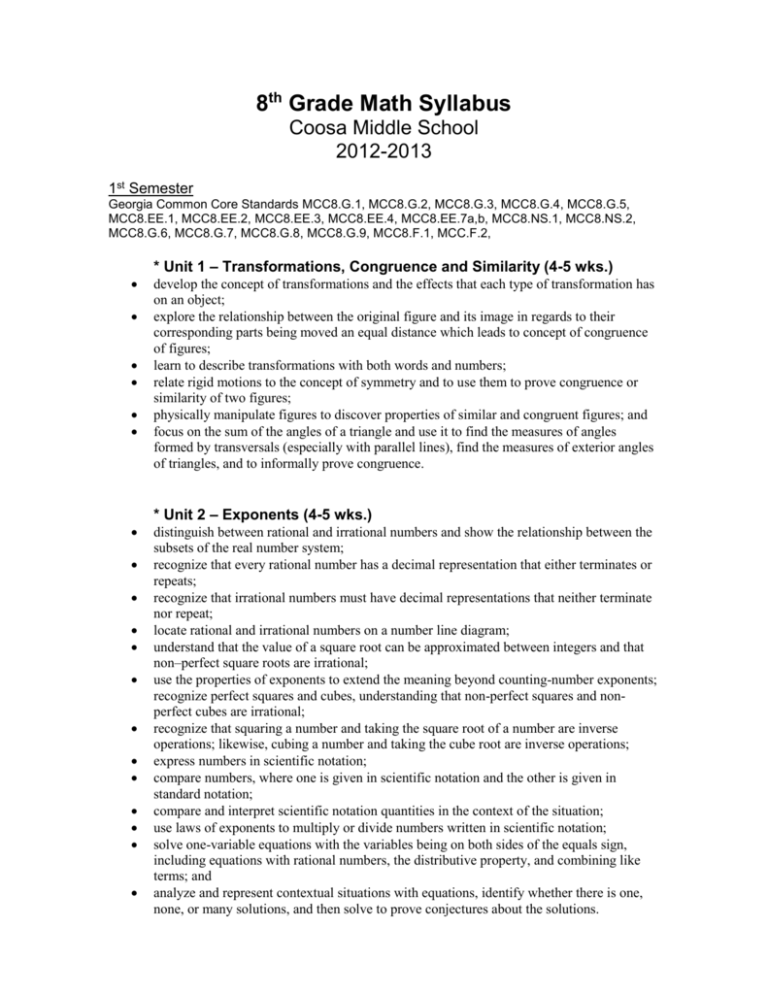
8th Grade Math Syllabus Coosa Middle School 2012-2013 1st Semester Georgia Common Core Standards MCC8.G.1, MCC8.G.2, MCC8.G.3, MCC8.G.4, MCC8.G.5, MCC8.EE.1, MCC8.EE.2, MCC8.EE.3, MCC8.EE.4, MCC8.EE.7a,b, MCC8.NS.1, MCC8.NS.2, MCC8.G.6, MCC8.G.7, MCC8.G.8, MCC8.G.9, MCC8.F.1, MCC.F.2, * Unit 1 – Transformations, Congruence and Similarity (4-5 wks.) develop the concept of transformations and the effects that each type of transformation has on an object; explore the relationship between the original figure and its image in regards to their corresponding parts being moved an equal distance which leads to concept of congruence of figures; learn to describe transformations with both words and numbers; relate rigid motions to the concept of symmetry and to use them to prove congruence or similarity of two figures; physically manipulate figures to discover properties of similar and congruent figures; and focus on the sum of the angles of a triangle and use it to find the measures of angles formed by transversals (especially with parallel lines), find the measures of exterior angles of triangles, and to informally prove congruence. * Unit 2 – Exponents (4-5 wks.) distinguish between rational and irrational numbers and show the relationship between the subsets of the real number system; recognize that every rational number has a decimal representation that either terminates or repeats; recognize that irrational numbers must have decimal representations that neither terminate nor repeat; locate rational and irrational numbers on a number line diagram; understand that the value of a square root can be approximated between integers and that non–perfect square roots are irrational; use the properties of exponents to extend the meaning beyond counting-number exponents; recognize perfect squares and cubes, understanding that non-perfect squares and nonperfect cubes are irrational; recognize that squaring a number and taking the square root of a number are inverse operations; likewise, cubing a number and taking the cube root are inverse operations; express numbers in scientific notation; compare numbers, where one is given in scientific notation and the other is given in standard notation; compare and interpret scientific notation quantities in the context of the situation; use laws of exponents to multiply or divide numbers written in scientific notation; solve one-variable equations with the variables being on both sides of the equals sign, including equations with rational numbers, the distributive property, and combining like terms; and analyze and represent contextual situations with equations, identify whether there is one, none, or many solutions, and then solve to prove conjectures about the solutions. * Unit 3 – Geometric Applications of Exponents (4-5 wks.) distinguish between rational and irrational numbers; find or estimate the square and cubed root of non-negative numbers, including 0; interpret square and cubed roots as both points of a line segment and lengths on a number line; use the properties of real numbers (commutative, associative, distributive, inverse, and identity) and the order of operations to simplify and evaluate numeric and algebraic expressions involving integer exponents, square and cubed roots; work with radical expressions and approximate them as rational numbers; solve problems involving the volume of a cylinder, cone, and sphere; determine the relationship between the hypotenuse and legs of a right triangle; use deductive reasoning to prove the Pythagorean Theorem and its converse; apply the Pythagorean Theorem to determine unknown side lengths in right triangles; determine if a triangle is a right triangle, Pythagorean triple; apply the Pythagorean Theorem to find the distance between two points in a coordinate system; and solve problems involving the Pythagorean Theorem. * Unit 4 – Functions (2–3 wks.) recognize a relationship as a function when each input is assigned to exactly one output; reason from a context, a graph, or a table, after first being clear which quantity is considered the input and which is the output; produce a counterexample: an “input value” with at least two “output values” when a relationship is not a function; explain how to verify that for each input there is exactly one output; and translate functions numerically, graphically, verbally, and algebraically. * 1st Semester Final Exam 2nd Semester Georgia Common Core Standards: MCC8.EE.5, MCC8.EE.6, MCC8.EE.8a,b,c, MCC8.F.3, MCC8.F.4, MCC8.F.5, MCC8.SP.1, MCC8.SP.2, MCC8.SP.3, MCC8.SP.4 * Unit 5 – Linear Functions (3-4 wks.) graph proportional relationships; interpret unit rate as the slope; compare two different proportional relationships represented in different ways; use similar triangles to explain why the slope is the same between any two points on a nonvertical line; derive the equation y = mx for a line through the origin; derive the equation y = mx + b for a line intercepting the vertical axis at b; and interpret equations in y = mx + b form as linear functions. * Unit 6 – Linear Models and Tables (5-6 wks.) identify the rate of change and the initial value from tables, graphs, equations, or verbal descriptions; write a model for a linear function; sketch a graph when given a verbal description of a situation; analyze scatter plots; informally develop a line of best fit; use bivariate data to create graphs and linear models; and recognize patterns and interpret bivariate data. * Unit 7 – Solving Systems of Equations (4-5 wks.) understand the solution to a system of equations is the point of intersection when the equations are graphed; understand the solution to a system of equations contains the values that satisfy both equations; find the solution to a system of equations algebraically; estimate the solution for a system of equations by graphing; understand that parallel lines have will have the same slope but never intersect; therefore, have no solution; understand the two lines that are co-linear share all of the same points; therefore, they have infinitely many solutions; and apply knowledge of systems of equations to real-world situations. * Show What We Know (3-4 wks.) Cumulative review of all units using performance tasks and projects * Preview of 9th Grade CCGPS * Cumulative Final Exam During the school year we will use the Common Core Georgia Performance Standards. These standards have been designed by Georgia to increase student learning and performance. Students will be challenged with high expectations and will be required to show their ability to apply the skills they have learned in the classroom. Your child will be tested on these standards in the spring on the CRCT. Students will be covering the attached standards, completing performance tasks geared toward accelerating their knowledge, and working on math vocabulary. Students will have daily work, quizzes, performance tasks, and unit tests that will make up their grades. I am teaching the math enrichment class, so we will be moving along at a quicker pace and there may be additional tasks and projects assigned to the students. Please encourage your child to keep up with the daily work and to start projects in a timely manner. I will always allow ample time for projects to be completed. There is extra help available as needed. I will be available to assist your child on Wednesday afternoons with regular office hours from 3:30 p.m. to 4:30 p.m. Please feel free to e-mail me or call me concerning your child. The school number is 706-236-1856. My planning time is from 9:50 a.m. to 11:15 a.m. My email address is kduhamel@floydboe.net. I look forward to a wonderful year! ~ Kim Duhamel Grading Policy 25% Class Work, Daily Work, Quizzes, Homework 60% Test/Project Grades (5 pts. will be added to grades in this category) 15% Final Exam (9-week exams will be cumulative and count 2 test grades) -----------------------------------------------------------------------------------------------------------Please sign confirming that you have read the syllabus and return this page only to your math teacher. Thank you! Student Signature__________________________________________________________ Parent Signature___________________________________________________________ Parent E-mail Address:___________________________ Phone Numbers: Home:____________________Cell:____________________Work:________________
